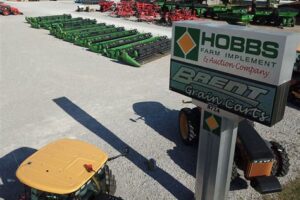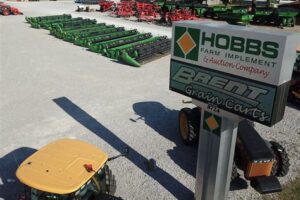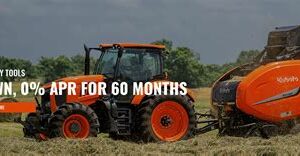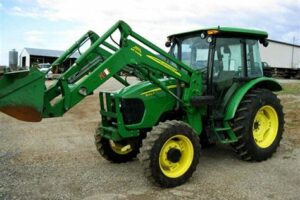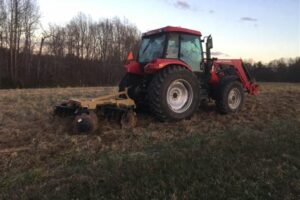Table of Contents
Obsolete Farm Equipment is a comprehensive guide exploring outdated tools and machinery used in agriculture. Discover the history, functionality, and significance of these relics from the past, and gain insights into how farming practices have evolved over time. From hand-operated tools to vintage tractors, this collection delves into the fascinating world of farming technology that has become obsolete in the modern era.
Obsolete farm equipment, relics of a time gone by, still hold a certain charm and intrigue for those who appreciate the history and evolution of agriculture. As one steps into a world where horse-drawn plows and hand-cranked threshers have long been replaced by modern machinery, a sense of nostalgia envelopes the mind. The clanking of rusty gears, the faded paint on weathered handles, and the musty smell of aged wood all tell tales of hard work, perseverance, and the ingenuity of generations past. In this ever-advancing world, these remnants stand as silent witnesses to the transformative power of innovation in farming.
Introduction
As technology advances and the agricultural industry evolves, many pieces of farm equipment become outdated and unused. These obsolete machines were once essential for farming operations, but they have been replaced by more efficient and modern equipment. In this article, we will explore some examples of obsolete farm equipment and discuss their historical significance.
The Horse-Drawn Plow
One of the most iconic symbols of traditional farming is the horse-drawn plow. Before tractors became commonplace, farmers relied on horses to till the soil. This piece of equipment helped break up the ground and prepare it for planting. However, with the advent of mechanized tractors, the horse-drawn plow has become obsolete. Its use is now mostly limited to historical reenactments or as decorative items on farms.
The Hand Crank Seeder
Before the invention of mechanical seeders, farmers relied on hand crank seeders to plant their crops. These small devices allowed for more precise seed distribution compared to manual methods. Farmers would operate the hand crank seeder while walking through the fields, releasing a consistent amount of seeds into the soil. Today, modern seeders attached to tractors have replaced this labor-intensive equipment.
The Threshing Machine
In the past, threshing machines were essential for separating grain from its husks and stalks. These large machines would separate the edible part of the plant from the undesirable parts, making it easier for farmers to collect and process their crops. However, with the invention of combine harvesters, which can perform multiple tasks simultaneously, threshing machines have become obsolete and are rarely seen in modern farming operations.
The Hand Hay Rake
Before the introduction of mechanized rakes, farmers had to manually collect hay using hand hay rakes. These rakes had long wooden handles and metal teeth that would gather and pile up the cut hay. While this method was effective, it was also physically demanding and time-consuming. Modern hay rakes attached to tractors have significantly increased efficiency, making the hand hay rake obsolete on most farms.
The Hand Corn Sheller
When corn was harvested by hand, farmers needed a tool to remove the kernels from the cob. The hand corn sheller was a handheld device with sharp metal teeth that would strip the corn kernels, allowing them to fall into a container. This manual process was eventually replaced by mechanical corn shellers, which could process larger quantities of corn in a shorter amount of time.
The Milk Pail
Before the advent of milking machines, farmers used milk pails to collect milk from cows. These pails were made of metal and had a handle for easy transportation. They were often used in conjunction with a milking stool, where the farmer would sit while manually milking the cow. Today, milking machines have largely replaced the use of milk pails, improving efficiency and reducing the physical strain on farmers.
The Hand Sickle
For centuries, the hand sickle was the primary tool for harvesting grain crops. This handheld cutting tool had a curved blade with serrated edges, making it efficient for cutting through stalks. However, as farming practices evolved and large-scale machinery became more common, the hand sickle fell out of use. Modern combine harvesters now perform the task of harvesting grain more quickly and efficiently.
The Wooden Plow
Before iron and steel plows became popular, farmers used wooden plows to till the land. These plows were typically made from a single piece of wood and had an iron blade attached to the front. While wooden plows were effective for breaking up soil, they were prone to breaking and required frequent repairs. The introduction of iron and steel plows revolutionized farming, rendering the wooden plow obsolete.
The Hand Broadcast Seeder
Before the invention of mechanical seeders, farmers relied on hand broadcast seeders to distribute seeds over large areas. These seeder devices allowed farmers to walk across a field while turning a crank, dispersing the seeds through a rotating mechanism. However, this method was imprecise and often resulted in uneven seed distribution. Today, precision mechanical seeders have replaced the hand broadcast seeder, ensuring more accurate planting.
Conclusion
Obsolete farm equipment represents a significant part of agricultural history. These machines played crucial roles in traditional farming practices but have become outdated due to advancements in technology. While they may no longer be in use, these pieces of equipment serve as reminders of the ingenuity and hard work of past generations of farmers. As the agricultural industry continues to evolve, it is essential to honor and preserve the legacy of these obsolete farm tools and machinery.
Introduction to Obsolete Farm Equipment
As the agricultural industry continues to evolve and embrace modern technology, certain farm equipment that was once instrumental in day-to-day operations has become obsolete. These outdated tools and machinery, which were once essential for farming tasks, now serve as historical relics, reminding us of how far the industry has progressed.
The Rise of Mechanization and Obsolescence
With the advent of mechanization in agriculture, manual labor-intensive tools such as hand plows and scythes have become obsolete. These once essential implements have been replaced by their mechanized counterparts, such as tractors and combine harvesters, allowing for increased efficiency and productivity on modern farms.
Outdated Irrigation Systems: A Thing of the Past
Obsolete irrigation systems, including wooden flumes and manual water pumps, have been replaced by more efficient and automated solutions. Traditional furrow irrigation methods, which relied on gravity-fed channels, have made way for advanced systems like center pivot irrigation, reducing water waste, and increasing precision in water delivery.
The Slow Decline of Horse-Drawn Implements
Horse-drawn farming implements, such as plows and harrows, have become obsolete as mechanized alternatives offer greater speed and precision. The use of horse-drawn equipment, once a common sight on farms, has dwindled due to the advent of machinery that can perform the same tasks more efficiently, reducing reliance on animal labor.
The Evolution of Livestock Management Tools
Obsolete livestock management equipment, like manual milking machines and hand-held tools for branding or tagging, have been replaced by automated systems that increase efficiency and reduce human labor. Modern farmers now rely on technologies such as robotic milking machines and electronic identification systems for animal management, making manual methods obsolete.
The Transition from Hand-Sowing to Modern Planters
Hand-sowing tools like seed broadcasters and manual seed drills have been rendered obsolete by mechanical planters. These advanced machines allow for precise seed placement, uniform spacing, and increased speed, resulting in improved crop yield and reduced labor costs for farmers.
Obsolete Harvesting Tools: A Relic of the Past
Scythes and sickles, once staples in the agricultural industry for cutting crops, have given way to powerful combine harvesters. These modern machines offer increased speed, efficiency, and can handle large-scale harvesting operations, making traditional harvesting tools a nostalgic reminder of the past.
Storage Solutions: Moving Beyond the Barn
Traditional barns and granaries, once used for crop storage, have become obsolete due to the introduction of modern storage facilities. Advanced technologies such as climate-controlled warehouses and grain silos now provide efficient, protective, and scalable storage options for farmers, reducing spoilage and increasing overall productivity.
In conclusion
As the agricultural industry continues to progress, obsolete farm equipment serves as a testament to the advancements and innovation that have shaped modern farming practices. These outdated tools and machinery remind us of the rich history of agriculture and the remarkable strides taken to make farming more efficient, sustainable, and productive.
Obsolete farm equipment refers to machinery and tools that have become outdated or are no longer in use due to advancements in technology or changes in agricultural practices. While some may argue that these pieces of equipment are no longer useful, there are several points to consider when evaluating their value and relevance in modern farming.
1. Historical significance:
- Obsolete farm equipment holds historical value as it represents the evolution of farming practices over time.
- These tools provide a glimpse into the challenges and hardships faced by earlier generations of farmers.
- Preserving and showcasing these artifacts can help educate future generations about the agricultural heritage of a region.
2. Learning opportunities:
- Studying obsolete farm equipment can provide valuable insights into the ingenuity and problem-solving abilities of past farmers.
- Understanding how these tools were used can help modern farmers appreciate the advancements in technology that have made their work more efficient and productive.
- By examining the limitations of older equipment, farmers can gain a deeper understanding of the challenges faced by their predecessors and develop innovative solutions to current farming issues.
3. Repurposing and recycling:
- Obsolete farm equipment can often be repurposed for other uses on the farm or transformed into decorative pieces.
- Recycling these items can contribute to sustainable farming practices by reducing waste and promoting resourcefulness.
- Additionally, repurposing old equipment can save money for farmers who may not have the means to invest in expensive modern machinery.
4. Cultural and artistic value:
- Obsolete farm equipment can have cultural significance, representing the traditions and way of life of a particular farming community.
- These tools can inspire artists and craftsmen to create unique pieces that celebrate rural heritage.
- Using old equipment as artistic installations or garden ornaments can add character and charm to farm landscapes.
In conclusion, while obsolete farm equipment may no longer serve its original purpose, it remains relevant in terms of historical, educational, and cultural significance. By recognizing the value of these artifacts, farmers can gain a deeper appreciation for their own profession while preserving the agricultural heritage for future generations.
Thank you for taking the time to visit our blog and explore the fascinating world of obsolete farm equipment. We hope that this article has provided you with valuable insights and knowledge about the history and significance of these forgotten tools. As we conclude our discussion, we would like to leave you with some final thoughts.
First and foremost, it is important to recognize the invaluable role that obsolete farm equipment has played in shaping agricultural practices throughout history. These tools, although no longer in use, have paved the way for modern innovations and have contributed to the efficiency and productivity of farming. Understanding their origins and functions allows us to appreciate the advancements made in the field of agriculture and the hard work of those who came before us.
Furthermore, exploring obsolete farm equipment offers a unique opportunity to preserve our rural heritage and foster a sense of nostalgia. These artifacts serve as tangible reminders of a bygone era, and by learning about them, we can gain a deeper understanding of the challenges and triumphs experienced by our ancestors in their pursuit of sustenance and survival. It is through this appreciation that we can ensure that their legacy lives on and that future generations remain connected to their agricultural roots.
Lastly, reflecting on obsolete farm equipment encourages us to consider the importance of sustainability and innovation in modern farming practices. As we face pressing issues such as climate change and food security, it is crucial to continually seek new ways to improve and adapt our agricultural methods. By studying the past, we can draw inspiration from the ingenuity of those who worked with limited resources and apply it to our current agricultural systems, promoting a more sustainable and resilient future.
In conclusion, we hope that this exploration of obsolete farm equipment has been both informative and inspiring. By delving into the history of these tools, we gain a deeper appreciation for the progress made in agriculture and the challenges overcome by generations before us. Let us continue to learn from the past, honor our rural heritage, and strive for a more sustainable future in farming. Thank you once again for joining us on this journey.
Video Obsolete Farm Equipment
People also ask about Obsolete Farm Equipment:
-
What is considered obsolete farm equipment?
-
Why is it important to identify obsolete farm equipment?
- To optimize farm operations: By recognizing equipment that no longer serves its purpose effectively, farmers can allocate resources towards acquiring modern and efficient tools that enhance productivity.
- Cost savings: Eliminating or replacing obsolete equipment can reduce maintenance and repair expenses, as well as minimize downtime, resulting in long-term cost savings for farmers.
- Safety considerations: Outdated equipment may pose safety risks due to malfunctioning parts or inadequate safety features. Identifying and replacing such equipment helps ensure the well-being of farm workers.
- Environmental impact: Obsolete machinery might be less fuel-efficient or contribute to increased emissions. Upgrading to newer models can help promote sustainable farming practices.
-
How can I dispose of obsolete farm equipment?
- Sell or trade-in: If the equipment is still functional, you can try selling it to other farmers or trade it in when purchasing new machinery.
- Scrap or recycle: If the equipment is beyond repair or no longer of value, you can contact local scrap yards or recycling centers that specialize in handling metal or agricultural waste.
- Donate: Consider donating the equipment to educational institutions, museums, or organizations that may find value in preserving and showcasing obsolete farm machinery.
-
Are there any benefits to preserving obsolete farm equipment?
- Historical significance: Obsolete machinery represents a part of farming history and can provide insights into past agricultural practices. Preserving them helps maintain a connection to our heritage.
- Educational purposes: Museums, educational institutions, or farm exhibits can use obsolete farm equipment to educate visitors about the evolution of farming technology and its impact on society.
- Appreciation of progress: By comparing obsolete equipment with modern counterparts, we can appreciate how far farming technology has advanced and the improvements it has brought to the industry.
Obsolete farm equipment refers to machinery or tools that are no longer used or have become outdated due to advancements in technology, changes in farming practices, or the availability of more efficient and modern equipment.
Identifying obsolete farm equipment is crucial for several reasons:
There are several options for disposing of obsolete farm equipment:
Preserving obsolete farm equipment can have various benefits:
Remember to consult experts or professionals in the field for specific advice regarding obsolete farm equipment.

